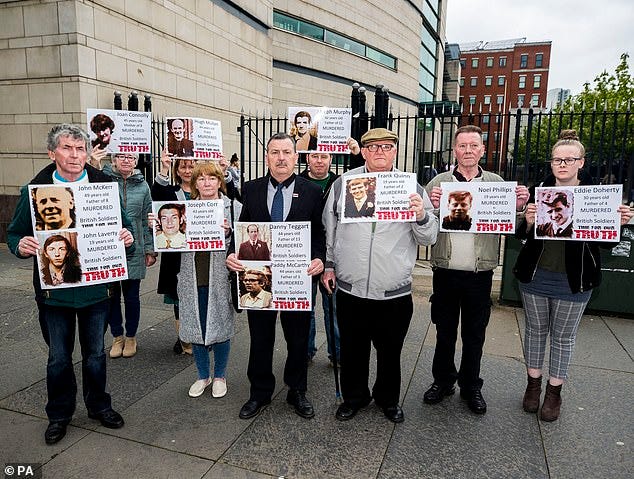I recently watched The Ballymurphy Precendent, a documentary about the Ballymurphy Massacre in which 10 innocent Catholics were shot and killed by forces of the British Army, and the ensuing, but not surprising, cover-up.
The Troubles in Northern Ireland were well under way when 1st Battalion, Parachute Regiment of the British Army, known as 1 Para, were sent into the town of Ballymurphy in Belfast, Northern Ireland to enforce the new internment without trial ruling. This military action in a civilian town was called Operation Demetrius. The Stormant Unionist government of Northern Ireland had introduced Operation Demetrius to break the back of the IRA. Unfortunately, faulty evidence led to the arrest of 100’s of innocent civilians, most of whom were released within 48 hours. The brutal and undisciplined reaction of 1 Para led to the slaughter of 10 Ballymurphy citizens (another man died of a heart attack during a confrontation with troops) and instigated a recruitment boom for the IRA.
Prior to this incident, the IRA was not widely popular with the Catholic community, and certainly not looked upon as an antidote to Unionist violence. One of the nicknames for the IRA at the time was I Run Away. After the massacre, though, support within the community did increase, as did the violence and destruction from both sides. During the 1916 Easter Rising a similar result ensued, especially after the government made martyrs our of a group of poets and teachers.
In the years preceding the massacre, calls for civil rights for Catholics, including an end to job and housing discrimination, repeal of the Special Powers Act, and reform of the RUC, were met with Unionist backlash, protests, rioting, and violence. The government clamped down harder on the Catholic community using their own brand of violence to further oppress the Catholic population, especially in the cities of Belfast and Derry. Bombs, beatings, barricades, and constant clashes between the various paramilitary groups, the security forces, and regular citizens escalated in the early 1970’s, with 1972 marking the worst year of the conflict. Tensions were very high in the summer of 1971. It’s hard to understand why anyone in the government thought sending 1 Paras in would help the situation. Maybe helping the situation was never the government’s intention.
1 Para had been used by the British government on several other occasions to quell uprisings by native populations in the fading empire’s colonies. They were known to move fast, decisively, brutally, and without remorse. Early in the morning on August 9, 1971 they descended on Ballymurphy, took up positions throughout the town, broke into homes and began arresting anyone suspected of being an IRA member, and proceeded to go on a three-day spree of violence and murder. At the time, and even years later when the truth was coming out, soldiers and leaders of the army and government tried to claim that the victims were IRA gunmen. No evidence supported that then or later. The victims were ordinary citizens. No weapons were found near any of them. No bomb residue was found on them. No IRA connections were exposed. Several were shot multiple times, in the back, at close range, into their already existing wounds. The first two victims, Francis Quinn and Fr Hugh Mullan, were shot will assisting the injured. Joan Connelly, a 44 year old mother of eight, might have survived her injuries, but she lay on the ground for several hours and bled to death.
One of the most poignant and shocking scenes in the film involves how and when the family members realized how many of their loved ones had died that day. The army PR machine had done an incredible job of covering up the killing of innocent civilians and instilling fear in the community so much so that people living in a small community didn’t realize the implications of all those deaths. In fairness, the situation in Northern Ireland was increasingly chaotic and the official investigations were incomplete, shoddy, and seemingly pre-ordained to let 1 Paras off the hook. It seems that no one in the media was curious enough to investigate further or question the government and army propaganda. It took years to piece it all together. In the end, though, it seems likely that the response of the government only added fuel to the fire in Northern Ireland and led to more violence, more deaths, more destruction. The film shows the devastation and loss suffered by the survivors. It’s a heart wrenching and frightening look at the long lasting damage caused by institutional corruption. If they’d only told the truth in 1971 so much might have been different in Northern Ireland.
Less than six months after the Ballymurphy Massacre, 1 Para was sent to quell another uprising, this one in Derry on Sunday, January 30, 1972. 1 Paras shot 26 people, killing 14 (13 that day and 1 several months later). The British government covered that massacre up as well.
The documentary made me think again of how governments and institutions so often try to cover up their misdeeds, despite the lessons of history. I wonder why they think they will get away with it. Did Stormont and the British Army really think that these murders would never come to light? I suppose they must have because they’d gotten away with it before or so they thought.
If the ugly truth isn’t exposed to the light and dealt with in full then it festers, as it did in Northern Ireland, causing so much damage. Even today, despite the Good Friday Agreement, there’s only a tenuous peace in Northern Ireland because the government and the army have not been completely honest. I can’t help thinking that in our present situation - COVID, lockdowns, troubled economies - that it won’t all start again. God willing, it won’t.



